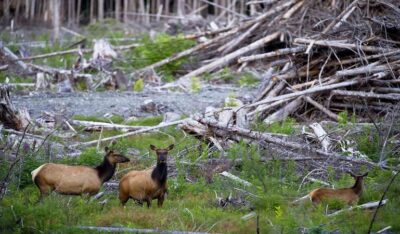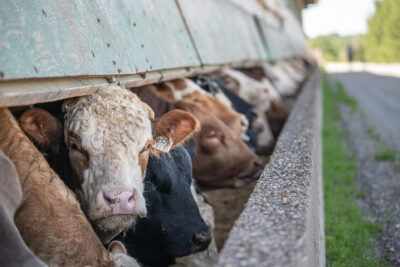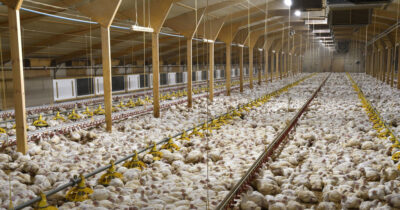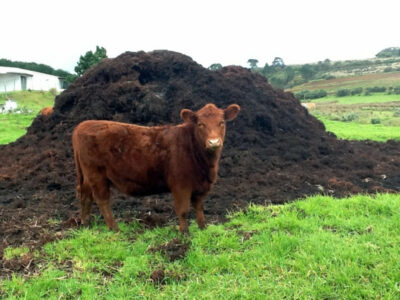Every living being needs a home, whether that’s people, plants, birds, or insects. But human activity, particularly animal farming, is depriving billions of animals of their homes and pushing some species towards extinction. The good news is that by changing the way we eat, it’s still possible to reverse this damaging trend and help animals to thrive.
WHAT IS A HABITAT?
A habitat is the home of an animal, plant, or other organism that provides everything they need to survive: water, food, shelter, and space. Forests, rivers, scrubland, deserts, and coral reefs are all habitats for different species. Some animals need multiple types of habitat, like peregrine falcons who need both cliff faces to nest in and extensive open land to hunt in. Urban environments have also become homes to many kinds of plants and animals, such as pigeons and squirrels who have made their homes in towns and cities.
WHAT IS HABITAT LOSS?
Habitats can be completely or partially destroyed, reducing their number or size. This means the animals who lived there will either not be able to survive or will be displaced to habitats that may be less suitable for them. Either way, numbers plummet.
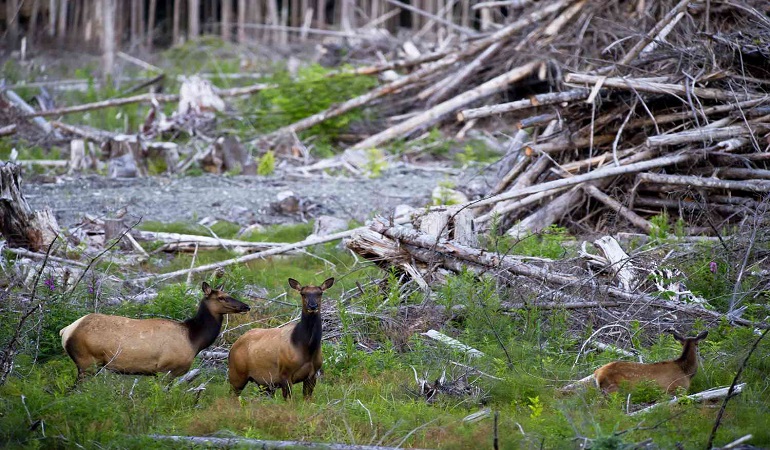
WHAT ARE EXAMPLES OF HABITAT LOSS?
Deforestation is probably the most well-known instance of habitat loss, but forests are not the only type of habitat being destroyed by human activity. Wildflower meadows in the UK, for example, have been almost wiped out, with 97 per cent lost since the 1930s. Globally, wetlands are vanishing three times faster than forests.
WHAT ARE THE THREE TYPES OF HABITAT LOSS?
DESTRUCTION
A habitat has been destroyed when it has been damaged or reduced to the point where it can no longer support the animals who would naturally be found there. Habitat destruction is often caused by people, but it can also occur as a result of extreme weather events such as flooding or natural disasters like earthquakes. In the oceans, habitats can be destroyed by pollution, eutrophication (when oxygen in the water is depleted by pollution that causes algal blooms to form), and by physical destruction such as when bottom-trawling fishing vessels drag heavy nets across the seabed.
FRAGMENTATION
Habitats become fragmented when they are broken up into smaller, isolated pieces. Imagine a forest that has roads running through it, separating one area of forest from another and creating a barrier for animals who would otherwise move freely between different parts of the forest. The conditions within habitats are also altered by fragmentation via what is called the edge effect: a fragmented habitat has many more edge areas that will be exposed to the elements, making it harder for animals who like shady or protected interiors.
DEGRADATION
The quality of a habitat can be degraded by pollution and climate-related events like droughts, leaving animals and plants struggling to survive. More than 75 per cent of land on Earth has been subject to substantial human impacts that are negatively affecting biodiversity and ecosystem services, according to a 2018 report by the Intergovernmental Science-Policy Platform on Biodiversity and Ecosystem Services (IPBES), with many areas having been deforested, polluted, or made into desert.
WHAT ARE THE MAIN CAUSES OF HABITAT LOSS?
AGRICULTURE
Agricultural expansion is the biggest cause of habitat loss globally. Land is cleared for growing crops, mostly to feed farmed animals and to graze them, leaving wild species with ever fewer places to live. This expansion has occurred rapidly; 1,000 years ago, about four million square kms of land was used for agriculture, whereas today it’s over 48 million — around half of the world’s habitable land. Alarmingly, scientists estimate that a further 2-10 million square kms of land will be cleared for agriculture by 2050 if we continue to eat the way we do today.
CLIMATE CHANGE
The climate is changing so fast that many species are struggling to adapt. Having evolved to flourish under certain climatic conditions, which influence things like hibernation, mating, and the availability of food, they are left unable to survive in their native habitats. Some are moving farther north, though with so much habitat either destroyed or degraded, many will never find safe refuge. Those who can’t migrate easily, such as plants, are at risk of going extinct locally.
LAND CONVERSION FOR DEVELOPMENT
Although it can seem like a lot of the planet is built-up and concreted over, only one per cent of all land is occupied by towns, cities, villages, and infrastructure. But new construction can still have an impact at smaller scales. Development of urban green spaces such as parks or meadows can leave city-dwelling species with nowhere to live.
Outside towns and cities, road building is a form of development that has serious impacts on habitats. One study found that, globally, roadless areas are fragmented into 600,000 pieces, many of which are very small — indicating a huge amount of habitat fragmentation. Roads also facilitate further habitat destruction by enabling people to reach new areas and carry out activities like mining, logging, and hunting.
MEAT AND DAIRY PRODUCTION
Of all the land used for agriculture, a massive 77 per cent is used for raising animals for meat and dairy, including grazing land and land used for growing animal feed crops. Sheep and cows raised for their meat require the largest amount of land, followed by animals raised to make cheese and milk. Deforestation in the Amazon and other significant habitats in South America is being driven largely by clearing land for grazing cattle and growing soy to feed animals like chickens, pigs, and fish trapped in factory farms around the world.
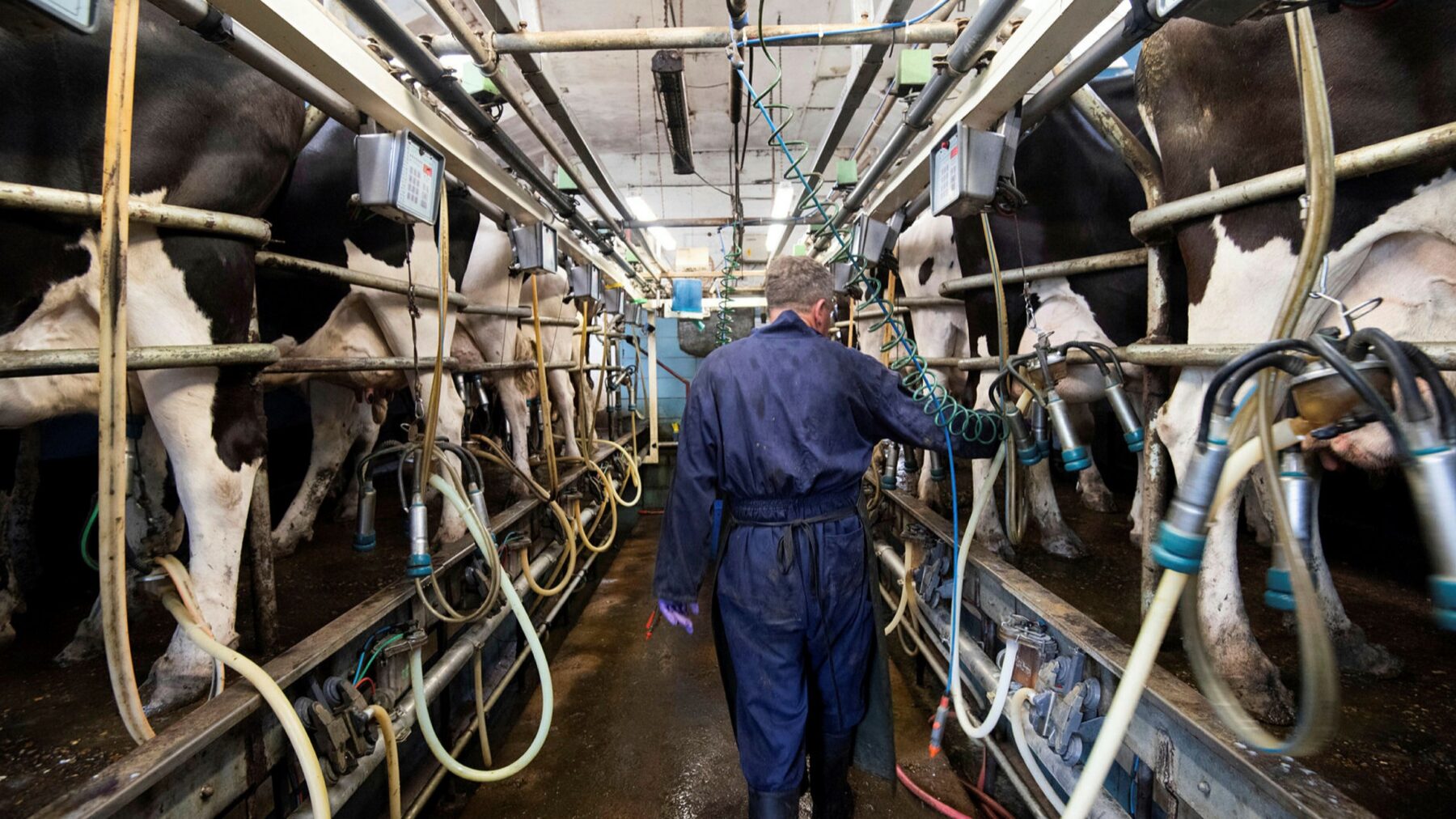
OVERGRAZING
Not all grazing land was formerly forest; some is grassland, which can be seriously damaged when cows and sheep are allowed to spend too long grazing it. Overgrazing happens when animals eat plants before they’ve recovered from previous grazing. This leaves grasslands with degraded soil, a reduction in plant diversity, and less food for wild herbivores to eat.
POLLUTION
Pollution comes in many forms, degrading habitats and making them uninhabitable for many species. Chemical plants, energy production from fossil fuels, and agriculture are all major sources of environmental pollution. Agriculture creates pollution mainly through animal waste and spraying pesticides and herbicides. Nitrogen pollution from farmed animal waste is a major concern, impacting waterways and contributing to greenhouse gas emissions. This problem is forcing a reckoning over the number of animals used for meat and dairy, with the Dutch government now actively trying to reduce their numbers. In the UK, animal agriculture was the cause of 300 incidents of river pollution in 2021, with 20 of those being considered major incidents.
WATER DEVELOPMENT
Building infrastructure in waterways or altering their natural course can significantly impact these habitats. Dams built across rivers generate electricity and create reservoirs to supply water for industry, farming, and households. But overall they have a negative impact on water quality and on wildlife and vegetation in the water and on land, for example by blocking fish migration. Only 37 per cent of rivers that are longer than 1,000km flow freely for their whole length; the rest are obstructed by dams and reservoirs.
WHAT ANIMALS ARE AFFECTED BY HABITAT LOSS?
Some animal species have become the poster children for habitat loss: orangutans in Indonesia, whose rainforest habitat is being cleared for palm oil plantations; polar bears clinging on in the rapidly melting Arctic; tigers in south-east Asia losing their homes as agriculture and logging for timber spread across their ranges. But these are just some of the most visible and publicly beloved animals to suffer from habitat loss. In the UK, the loss of habitat to farming has left the turtle dove endangered, for example, while numbers of the Cosnard’s net-winged Beetle have dropped due to the felling of large old beech trees where the beetles spend most of their time. It’s estimated that the habitats of 90 per cent of animal species will be negatively impacted by agricultural expansion by 2050 unless we change the way we eat.
HOW DOES LOSS OF HABITAT AFFECT ANIMALS?
LESS POLLINATION AND SEED DISPERSAL
Of the processes involved in plant regeneration, pollination and seed dispersal are the most sensitive to human disturbance. Most flowering plants depend on animals for pollination, while the diversity of plant species depends heavily on seed dispersal by animals, but the fragmentation of habitats hampers both of these activities. Animals who are selective about which flowers they visit are declining as they struggle to find the right plants. A loss of nesting and breeding habitat is also contributing to the decline of pollinators like butterflies and some bee species.
REDUCED BIODIVERSITY
When habitats are destroyed, degraded, or fragmented, fewer individuals can survive there, and those who do survive have fewer breeding options. This means that both the number of species and their genetic diversity are impacted by habitat loss. Animals who can’t survive outside specific habitats go locally extinct, reducing the variety of species found there.
RIPPLE EFFECTS ON OTHER SPECIES
When one species dies out, declines, or is displaced due to habitat loss, the effects can be felt by many other species. It can disrupt the food chain, depriving predators of prey and enabling other species to become abundant because their numbers are no longer being controlled. This may sound like good news for some, but their food source will not have increased and so animals may starve. Habitat loss also affects the way species interact with each other by, for example, limiting the movement of predators, which alters feeding habits.
HOW DOES LOSS OF HABITAT AFFECT HUMANS?
CARBON DIOXIDE EMISSIONS
Many habitats store a significant amount of carbon, and when they are destroyed, that carbon gets released into the atmosphere. For example, the destruction of tropical forests between 2015 and 2017 emitted about 4.8 billion tonnes of carbon dioxide each year. Peatlands, which can be home to hundreds of species of invertebrates, mammals, birds, and plants, store even more carbon than forests — about 25 per cent of global soil carbon — even though they only cover three per cent of land. But when they are drained to be turned into agricultural land their immense carbon stores are released. These emissions make a significant contribution to climate change, the effects of which include greater spread of infectious diseases, the displacement of millions of people due to extreme weather events, and increasing numbers of serious drought and heatwave events in future.
CROP FAILURE
By contributing to climate change, habitat loss contributes to the worsening droughts, floods, and heatwaves that are capable of destroying harvests of globally important crops like wheat. The loss of habitats like rainforest can also alter patterns of rainfall on which crops depend.
HOW MANY ANIMALS DIE FROM HABITAT LOSS?
It’s hard to put an exact number on how many animals die as a result of losing their habitats, but a major report published in 2020 showed that the populations of 4,392 different vertebrate species — mammals, fish, birds, and amphibians — have declined by an average of 68 per cent since the 1970s, with forest clearing for agricultural expansion being the main driver. Of course, if we just ate plants, we would need just a fraction of this land.
Scientists are sometimes able to estimate the number of animals who die in specific events, such as wildfires. The devastating Australian wildfires of 2019 and 2020, for example, may have killed around three billion animals.
HOW TO COMBAT HABITAT LOSS
USE LESS PALM OIL
Palm oil is everywhere: in our food, our beauty products, and our cleaning products. Its versatility has led to the destruction of large swathes of rainforest, particularly in Indonesia, to make way for palm oil plantations. One way that individuals can address this problem is to avoid products that contain palm oil wherever possible. Some rainforest campaigners suggest ensuring any products containing palm oil that you do buy are certified by the Roundtable on Responsible Palm Oil (RSPO), but the Environmental Investigation Agency has accused the RSPO of greenwashing destructive practices.
REDUCE YOUR WATER USAGE
Wasting water puts strain on sources of freshwater that other species depend on for survival. There are lots of well-known ways to reduce your water use, like taking shorter showers and not flushing toilets more than necessary, but a less talked about solution is to eat less water-intensive foods. Around 70 per cent of freshwater use occurs in agriculture. The food with the biggest water footprint is cheese, by quite a long way, but prawns and beef are also major users. Almost all vegetables and plant products use a lot less water than animal-based foods.
PLANT A GARDEN
There are around 15 million gardens across the UK which, taken together, comprise a pretty big area of land that could be used to help wildlife thrive. Leaving areas to go wild, digging a small pond, creating wood piles, sowing wildflowers, and planting hedges instead of putting up fences are all great ways to help turn a garden into habitat for animals such as birds, insects, hedgehogs, and frogs.
HALVE FOOD WASTE AND LOSSES
Globally, around 30 per cent of all food produced is lost or wasted. Wasted food means that the resources needed to produce it have been wasted too. From a land-use perspective, around 3.4 million acres of land is used to grow food that is wasted — land that would have once been habitat for wildlife. Halving food waste by 2030 is part of the UN’s Sustainable Development Goals, and a goal committed to by many European countries in 2017.
DON’T USE FERTILISER
Using a lot of synthetic phosphorus and nitrogen fertiliser to grow crops often results in it washing away during rain, contributing to eutrophication in waterways. Organic fertiliser — mainly farmed animal waste — is also a major source of nitrogen pollution. It’s possible to grow food without using synthetic or animal-based fertiliser, using techniques such as growing certain crops between harvests, as shown by stockfree organic or vegan organic/veganic farmers, though these techniques are not yet widely used.
EAT A HEALTHY VEGAN DIET
A healthy, plant-rich diet requires far fewer resources than one that contains lots of animal products. What constitutes a healthy diet varies across different parts of the world according to cultural traditions and locally available food, but it’s clear that a global shift towards plant-based diets would save a lot of habitat from being destroyed and free up 75 per cent of existing agricultural land, which could then be allowed to regenerate naturally. A vegan diet is great for protecting habitats and the animals who depend on them.
CONCLUSION
Humans are largely responsible for destroying the habitats of other species — hurting them as well as ourselves. With agricultural expansion driving this loss, it’s clear that what we eat and how we produce it needs a radical change, and quickly.

